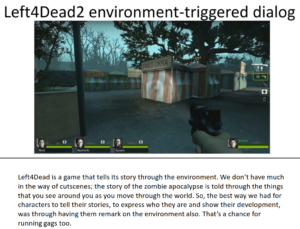A few days ago, I read through Elan Ruskin’s excellent 2012 GDC presentation on how Valve handled character dialogue in Left4Dead and I felt like I understood about two thirds of it, which is pretty good. (I read it instead of watching it because GDC doesn’t seem to have any videos on YouTube from that long ago, nor do they seem to upload videos that get this explicitly technical, but Ruskin put his slides and script online, which is a very awesome thing to do.) Left4Dead’s dialogue system is a marvel and it’s my opinion that anyone interested in making character-driven games should make themselves familiar with how it works.
(Because Left4Dead and Left4Dead2 are basically the same game, I’ll be mostly referring to them as if they were just one title.)
In particular, I’ve been interested in how systems like this could apply to JRPGs, which are my main area of interest but have been developmentally stagnant since at least the PlayStation 1 era. Other genres have thoroughly pilfered what were once considered to be RPG mechanics—variable statistics, unlockable abilities and so on—but RPGs haven’t done the same in return, and its most critical flaw, the strict segregation of storytelling and gameplay, going almost entirely unaddressed. For a genre that sells itself on the strength of its writing, it’s not a great thing for plot and character development to come to a halt the moment a player starts navigating a dungeon or fighting trash mobs.
Continue reading “Left4Dead’s contextual storytelling and JRPGs”
